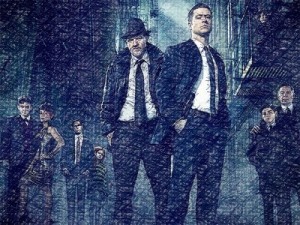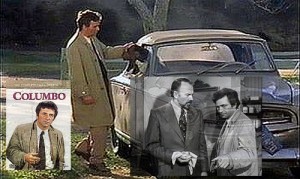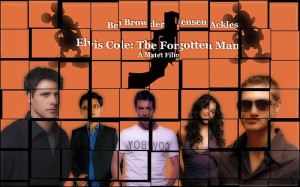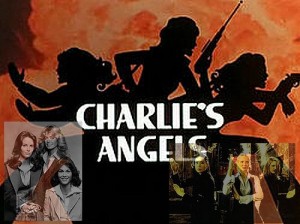This is a temporary post that was not deleted. Please delete this manually. (f68244df-8b99-4e73-96f6-8918f5538d20 – 3bfe001a-32de-4114-a6b4-4005b770f6d7)
Latest Entries »
Dr. Temperance "Bones" Brennan, Ph.D. is both a fictional character who features in the best-selling novels created by author Kathy Reichs and the lead female character in a Fox TV series partly based on the novels.
On television, Emily Deschanel portrays Dr. Brennan, and former "Angel" star David Boreanaz is FBI Special Agent Seeley Booth.
Brennan gets shot:
The Premise
"Bones" (a nickname she doesn’t particularly like) is a genius forensic anthropologist, who also holds Ph.D.’s in anthropology and kinesiology. Working out of the Medico-Legal lab at Washington, D.C.’s fictional Jeffersonian Institute, she serves as a consultant to the FBI, where’s she’s partnered with Special Agent Seeley Booth – her partner in a relationship outside the office that’s ultimately led to marriage and two kids.
Using her extremely high IQ, an obsessive adherence to scientific discipline, and mad forensic skills that have gained her a global reputation as an authority in the field, Dr. Brennan reconstructs murders based on the bone fragments and other organic residue discovered at a crime scene.
But her path to success wasn’t easy.
A Troubled Past
Brennan’s parents were notorious bank robbers, who changed their names from Ruth and Max Keenan and disappeared when Temperance (whose birth name was Joy Keenan) was 3 years old. She grew up in foster homes, and was often the victim of violent abuse. In later episodes of the TV series, it’s revealed that Ruth Keenan/Christine Brennan was murdered two years after she and her husband went on the run.
Max Keenan (played on TV by Ryan O’Neal) later came out of the shadows to assist his daughter when she became the target for a killer, and has returned on occasion as a recurring character in the show. So too has Temperance’s Benjamin Franklin-obsessed cousin Margaret Whitesell, who’s played by Emily Deschanel’s real-life sister Zooey.
A Brilliant Mind
Perhaps due to her blunted childhood, Brennan’s academic brilliance manifests as a Spock-like adherence to logic and scientific rigor, an inability to "get" traditional forms of humor or sarcasm, and awkward social skills. But she’s at heart a good and generous person, whose true character somehow always manages to transcend these limits.
Over several seasons of the TV series, "Bones" has mellowed and evolved, becoming a much more personable human being.
Bones not so cold:
Some Great Friends
A great influence on her is Brennan’s partner and FBI liaison, Seeley Booth. It was he who also coined the term "squints" for the forensic team at the Jeffersonian; brilliant scientists who squint at case evidence. "Bones" has a highly skilled set of colleagues, to assist in her investigations.
There’s Angela Montenegro, a talented forensic artist with prodigious 3D visualization skills, made even keener by the latest in holographic technology – who’s also Brennan’s best friend. Forensic pathologist Camille Saroyan is their department head at the Jeffersonian Institute, where entomologist Jack Hodgins performs magical feats of deduction using bugs, worms, maggots, or whatever species of vermin most infests a crime scene or corpse. And the team is assisted by a rotating set of quirky interns.
Some Great Television
"Bones" has been playing on Fox Television for several years, with season 8 culminating in the (finally…) marriage of Brennan and Booth.
Now into its 11th season, the show has an appreciable fan base – and the strength to try out new ideas, such as the recent crossover with the supernatural detective series "Sleepy Hollow":
"Bones"-"Sleepy Hollow crossover
Word and Screen
There are currently 17 Temperance Brennan novels which have been penned by Kathy Reichs. The books share only a loose continuity with the TV show. But notably, the television series features a direct and ongoing link: Emily Deschanel’s "Bones" is an internationally best-selling novelist whose detective fiction features a forensic anthropologist named Kathy Reichs, whose life and methods mirrors that of Brennan’s own character.
Both the books and the show are well worth a look.
Okay, so you’ve listened to the podcast (or not…). Here’s the original story, for you.
An Unreliable Sauce
By Des Nnochiri
Pedrosa was cutting it pretty fine.
18:30, he’d said. That was 6:30, in the P.M., for civilians.
Wallace twitched his lip. Approximation to a smile.
It was almost funny. The way Pedrosa had set up this rendezvous, in
military time. Laid out the terms and conditions of his “testimony”,
as if he were negotiating an armistice.
No names.
Pedrosa – if that was even his real moniker; the guy was an illegal,
like so many others at Blue Mountain – was to be credited as “an
anonymous source.”
No recording equipment.
Wallace was to get Pedrosa’s story, word for word. On paper.
Nuts, to that. Wallace’s secretarial skills were right up there, with his
great-grandmother’s – who’d been a professional seamstress.
Non-existent, in other words.
He’d called in some favors at Metro P.D., and gotten himself wired,
like an undercover Narc.
Brought a notebook and pen, for show. He’d do his own version of
shorthand.
Between that, Senor “Manuel Pedrosa’s” halting English,
Wallace’s own high-school Spanish (He’d flunked, spectacularly), and
the tape, he’d have what he wanted.
Pedrosa, spilling the beans on what was really going on with Blue
Mountain’s Everyman range.
Crouched beside the chain-link fence surrounding the canning plant,
Wallace reflected that something out of the ordinary must be going on,
here.
Something.
To justify the watch towers at every corner; machine gun emplacements
at the top. The CCTV cameras, patrolling guards, and sniffer dogs. The
crackling high voltage, coursing through the mesh of the fence.
They had to be protecting more than just a secret recipe for the
millions-selling All-Purpose Ragouts, the company was peddling.
Well, Pedrosa should be here soon, to shed some light.
Should.
But Pedrosa was…
Wallace checked his wristwatch.
He was going to be 15 minutes late. In another 5 minutes.
A sudden movement, to his right. Wallace flicked his eyes, in that
direction. Tensed, ready to run or fight.
“Ow!!”
A stinging pain, beneath his right ear. Instinctively, Wallace clapped
a hand to the spot. Slapping the tranquilizer needle even deeper, into
the skin.
He pitched forward, to the dirt. Unconscious, in seconds.
Wallace awoke to the glare of fluorescent lights, overhead. A large
space, like a warehouse or factory floor.
Flat on his back. And naked, as the day he was born.
He couldn’t make out what kind of surface he was lying on. Or
feel his legs. Arms. Anything else, for that matter.
He could hear, though. And see – even if his eyes could only stare
straight ahead.
What peripheral vision he had put him in a wide channel of some sort,
with knee-high walls of steel mesh. At a table nearby, workers in the
spotless overalls of the Blue Mountain Foods conglomerate pored over
Wallace’s clothing, with a fine-tooth comb.
That’s how he deduced that he was naked.
Peering down at him was a face he recognized from all the news reports
and business dailies.
Montague Kane. CEO, Blue Mountain Foods.
Kane held in one hand the mike and recording device which had been
taped to Wallace’s body, an expression of distaste on his patrician
features. Like everyone else, the man was wearing surgical gloves.
One of the technicians from the table approached Kane. His tone was
deeply respectful, as he confirmed that “We’ve done a sweep of the
area, sir. No surveillance vans, or back-up units. Mr. Wallace is
alone.”
Kane nodded. He handed the wire to the tech, holding it in his
thumb and forefinger, like a dead rat. His face didn’t
change, as he returned his attention to Wallace.
“Mr. Wallace is alone…”
The words seemed to echo through the room. They were all that Wallace
could focus on, even as Kane loomed above him. But the man’s lips were
moving. He was talking. Saying words that might – might – hold the key
to Wallace’s survival.
Because, make no mistake; Wallace knew that his life was in the balance, here.
He bore down, struggling to make out the words.
“Mr. Wallace is alone…”
Not quite, though.
Kane’s monologue on the merits of Everyman…
“Ranch House, Negrito. Our Everyman sauces are the favorite choice of
households across the country. Nutritious, naturally tasty, and
affordable…”
…Was interrupted, as a trio of workers passed behind him, lugging a
wrapped plastic bundle. They hoisted it over the channel wall.
The limp and naked body of Manuel Pedrosa landed with a thud, at Wallace’s feet.
If Wallace’s eyes could have widened in horror, they would have.
As it was, they could merely stare, as Kane continued speaking.
“Why, you may have used them, yourself. Very popular.
We’ve had our trials, of course. Who hasn’t? Civil suits. That unfortunate business
with the gender rights lobby. EveryWoman, EveryPerson, my ass.
And I’m sure you’ve heard the rumors, in the press. Else, you wouldn’t
be here.”
Kane chuckled. More like a death’s head grin, in that lean face.
“About our stringent work practices. Our unconventional
employment policy. Migrants, transients, runaways. We hire them, where
no one else will. I admit that. There’s no shame in it. And yes, I run
a tight ship. But, by taking these people off the streets – by giving
them a purpose – we are doing a public service.”
He leaned forward earnestly, now. Huckstering, like a cheap politician.
“You know, we ship over a million tonnes of our products every year, to
starving families in Africa and Asia? At no charge. Public service.
And, if we ask that our workers give something back, at the end of
their shift, that’s not unreasonable, is it?”
Kane paused, nodding to one of the technicians at the table.
As the tech guy flipped a switch, Kane resumed his discourse. Eyes
gleaming with fervor. A sheen of sweat, on his upper lip.
Speaking with the absolute conviction of the obscenely wealthy, and
utterly insane.
“The work force, now. They’re our life’s blood. Our strength. Our
special ingredient. The secret, to our sauce. You’ll see.”
Kane stepped back, out of Wallace’s line of sight.
At the far end of the hall, a mesh of sharpened steel blades whirred into life.
If Wallace could have thrashed and kicked, he’d be out of there, right
now. But…
“Mr. Wallace is alone…”
And the steel conveyor belt holding the bodies of Manuel Pedrosa and
Mr. Wallace chugged inexorably toward their special place in the
making of Blue Mountain Everyman.
Wallace wondered which variety he’d end up in.
END
As in, peace.
In a week that saw Fox’s “Gotham” achieve its best-ever ratings on US television, here’s a link to my article at the Xtreme Entertainment Network, reviewing the show’s first season, for UK audiences.
Oh, and best wishes for 2015. Hope it’s a good year, for all of us.
Peace.
In case you’re wondering where I’ve been, the answer is: BUSY.
My world outside the blogosphere has been chock-full of writing assignments in the tech arena. In parallel to that, there’s developing my own brand of crime and suspense fiction, trying to sell my screenplays, and the whole “trying to have a life” issue.
One of the jobs I did recently was a preview / review of The CW’s “The Flash”, for the UK market. I put it out through the Xtreme Entertainment Network, a start-up based in London. Xtreme specializes in video games, movies, TV, and related media.
Could be an outfit worth watching. “The Flash” certainly is.
You can check out
Peace.
Chief Inspector Jacques Clouseau of the Surete Nationale (a main arm of the French police forces) is a fictional character in Blake Edwards’ series of farcical “The Pink Panther…” films. In most of the movies actor Peter Sellers portrayed the character, who was to become one of Sellers’ pivotal roles.
He’s NOT The Pink Panther!
Which was actually a piece of jewelry; a diamond, targeted for stealing by the aristocratic British thief Sir Charles Lytton, a.k.a. “the Phantom”, in the 1963 comedy thriller “The Pink Panther”. The main focus of the film was on the plotting of actor David Niven, as Sir Charles, with Sellers’ Clouseau providing slapstick comic relief.
Sellers’ antics lent to the popular reception of the film, and established Clouseau’s method of operations; that of a complete buffoon who somehow manages to solve major crimes by a combination of blind luck, inept villains, and fortunate accidents. And the lingering suspicion that, somewhere in his head lurks the identity of a true detective.
The Pink Panther went on to give its name to a suave cartoon feline (who was to feature in the movie credits), and a series of sequels.
He’s had Many Faces:
* The 1964 sequel “A Shot in the Dark” was based on a stage play that didn’t originally include the Clouseau character. It was in this film that Sellers first developed the exaggerated French accent that became Clouseau’s trademark.
The movie introduced two of the series regular characters: Clouseau’s superior officer, Commissioner Dreyfus (actor Herbert Lom), who’s eventually driven mad by Clouseau’s bungling, and his long-suffering Chinese steward, Cato (Burt Kwouk), employed to improve Clouseau’s martial arts skills by attacking him at random.
* For 1968’s “Inspector Clouseau”, the detective was portrayed by American actor Alan Arkin. Blake Edwards was not involved in this production.
* “The Return of the Pink Panther” (1975) saw the return of Peter Sellers to the role of Clouseau – and a rematch with the villainous Sir Charles Lytton (now portrayed by Christopher Plummer). The opening credits were animated by Richard Williams, and feature Clouseau seeking to retrieve the Pink Panther diamond after it is stolen by the Phantom.
* “The Pink Panther Strikes Again” (1976) continued the story from the end of “The Return of the Pink Panther”.The now insane Dreyfus creates a crime syndicate and constructs a doomsday device, with the intention of using it to blackmail the world into killing Clouseau.
Here’s a scene, courtesy of YouTube, depicting Clouseau’s unique style of interrogation:
* Sellers and Edwards originally planned the events of “Revenge of the Pink Panther” (1978) as the basis for a British television series. The movie ignores Dreyfus’ apparent “death” in the previous film, and has Clouseau investigating a plot to kill him after a transvestite criminal is murdered in his place. The movie was a box office success, and led to several more films after Sellers died in 1980.
* 1982’s “Trail of The Pink Panther” was Blake Edwards’ attempt to continue telling Clouseau’s story, despite losing his lead actor. Using outtakes and alternative footage of Sellers as Clouseau, the film introduced a new storyline in which a reporter (played by Joanna Lumley) investigates Clouseau’s disappearance. Along the way, she interviews characters from past Clouseau films, and meets Clouseau’s equally inept father (played by Richard Mulligan).
Seems like a bad idea? Well…
* “Curse of the Pink Panther” (1983) continued the conceit, with the revelation that Clouseau underwent plastic surgery to change his appearance. The character appears briefly, in a joke cameo by Roger Moore, billed as “Turk Thrust II”. Neither “Curse” nor “Trail” was a box office success, and the series was retired.
* Edwards attempted to revive the series a decade later with “Son of the Pink Panther” (1993). Here, it is revealed that Clouseau had illegitimate children by Maria Gambrelli (played by Elke Sommer in A “Shot in the Dark”; recast in this film as Claudia Cardinale, who played the Princess in “The Pink Panther”).
Clouseau’s son, Jacques Jr., was portrayed by Roberto Benigni, and his twin sister, Jacqueline, played by Nicoletta Braschi. Jacques Jr. attempts to follow in his father’s police footsteps, but is soon revealed to have inherited the congenital Clouseau ineptitude.
* Steve Martin starred as Inspector Jacques Clouseau in the 2006 reboot of “The Pink Panther”. The story casts Clouseau as an inept Gendarme hired by Chief Inspector Dreyfus to serve as the figurehead investigator in a high-publicity murder, so that Dreyfus can carry out his own investigation, without risking the repercussions of failure.
Although foolish, Martin’s Clouseau is nonetheless able to locate the Pink Panther diamond and solve the case through his own knowledge, and observation of obscure data.
Martin’s Clouseau is considerably older than Sellers’ was, and although the 2006 film was placed prior to the events of the first Pink Panther film (Clouseau is still in uniform), the time frame is advanced to the present day.
Here’s a YouTube trailer, for you:
* “The Pink Panther 2” (2009): When a series of rare and historical artifacts are stolen by the mysterious Il Tornado, Clouseau is assigned to a “dream team” of international investigators to recover the relics – and the Pink Panther. Despite appearing bumbling and clumsy as usual, Clouseau once again displays surprising cleverness through his unorthodox methods.
Mad Skills
Clouseau is promoted to Chief Inspector over the course of the film series, and is regarded by background characters as France’s greatest detective – until they encounter him directly.
The Inspector (sorry; Chief Inspector) has an exaggerated view of his own intelligence, and attempts to appear dignified, regardless of any calamity he’s just caused.
He has a passion for elaborate costumes and aliases, ranging from the mundane (a worker for the phone company) to the ridiculous (a bucktoothed hunchback with an oversized nose). All of them are usually masked by his characteristic mannerisms – and accent.
Clouseau’s immense ego, eccentricity, exaggerated French accent, and prominent mustache were derived from Hercule Poirot, Agatha Christie’s fictional Belgian detective. A frequent running gag in the movies was that even French characters had difficulty understanding what he was saying!
Ironically, much of that humor was lost in dubbing the films into French, where Clouseau wound up with an odd-sounding, nasal voice.
Okay; that’s it, for this one.
See you, for the next – I hope.
Till then.
Peace.









